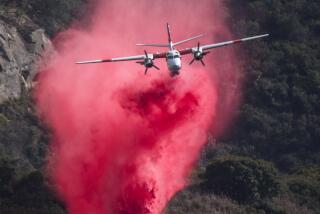Doctors Pursue Higher Calling in Outback
ALICE SPRINGS, Australia — Swatting away flies that revel in blazing desert heat, pilot Steve Patrick has barely returned his single-engine Pilatus PC12 to its hangar when the call comes in: “Code 1, emergency evacuation needed.”
Within minutes, the plane is back on the tarmac, Dr. Rod Mitchell is climbing aboard with a nurse, and the three are off to the middle of nowhere, just a regular stop on the largest doctors’ round in the world--Australia’s Royal Flying Doctor Service.
Less than two hours later at Kiwirrkurra, 215 miles across the red sand and sun-baked granite of the Gibson Desert, Mitchell stabilizes an Aboriginal woman who is having breathing difficulties caused by a clot in her lung and prepares to fly her to a hospital back in Alice Springs.
“She had a pulmonary embolus and couldn’t breathe. She needed oxygen,” said Mitchell, one of 35 doctors employed full-time by the service. “Code 1 means we get off the ground within half an hour.”
For more than 70 years, the Flying Doctors Service has been a mainstay of the sparsely populated Outback, providing medical supplies and treatment to areas where there is often no alternative and where the difference can be life and death.
Drive just a few hours inland from the coast, where most Australians live, and you are in Flying Doctors country. Other nations have medical air services, but Australia’s is the oldest and covers the most ground.
Its 83 pilots share duties in 38 planes stationed at 17 bases dotted across the country, serving 2.7 million square miles of scrubland and desert--an area more than two-thirds the size of the United States.
Aviation, Radio Enthusiasts Unite
At the Alice Springs base, senior pilot Greg Bath charts on a computer his second flight of the day--a 280-mile run west to Nyrrippi, an Aboriginal community of 250 people.
“On average we would fly 1,500 kilometers [930 miles] on two or three jobs” a day, he said.
The idea dates to the early 1900s, when a Presbyterian missionary, the Rev. John Flynn, traveled widely in central Australia and saw firsthand the rigors faced by Australia’s pioneering ranchers and miners.
On ranches bigger than some U.S. states, cowboys risked life and limb mustering grumpy steers over huge areas in search of water. At home, wives and children dodged poisonous snakes. If there were illness or infection, the ride to the nearest neighbor could take weeks.
Chasing gold, opals and other valuable minerals, miners were crushed or injured in dynamite explosions.
Flynn dreamed of building a “mantle of safety” for the Outback. He established the Australian Inland Mission in 1912, which built hospitals and clinics in the vast interior--known simply as “The Bush.”
After World War I, Flynn collaborated with aviation and radio enthusiasts who saw the potential of drawing together the two new technologies to serve remote regions.
Engineer Alfred Traeger developed a radio transmitter for Flynn that could be powered by foot pedals pumped by the operator. These were delivered to posts all over the Outback.
Later, the service distributed medical “chests” of supplies, which are still commonplace on many ranches and are used under instruction from doctors speaking by radio or telephone.
Lifeline Extends to End of the Road
The communications network is now one of the most comprehensive in Australia, reaching areas where telephone lines often don’t. The network is even used by thousands of children who take classes via the “School of the Air,” which links them to faraway teachers.
In 1928, Flynn’s newly established Aerial Medical Services hired its first doctor and made its first flight from Cloncurry, in Queensland.
In its first year, Dr. St. Vincent Welch made about 50 flights in the service’s only plane, a leased De Havilland DH50. He covered 20,000 miles and treated 255 patients.
As the service continued to grow, branches were established in each of Australia’s states. The service was renamed in 1942 and granted the “Royal” label in 1955.
By the mid-1970s, 22 planes were making 4,200 flights a year, covering 2.3 million miles and treating thousands.
Today, the charity’s own doctors are bolstered by physicians employed by the governments of Australia’s seven states and are assisted by 87 full-time nurses. The annual budget of around $10.5 million comes mostly from government grants and private donations.
Satellite communications, four-wheel-drive vehicles and helicopters for cattle roundups are signs that times have changed in the Outback. But not that much.
“There are times when town seems an awful long way away and the RFDS doctor’s voice is just wonderful to hear, especially in the middle of the night when one has a small child barely able to breathe due to croup,” said Vivienne Turner at Boorungie ranch outside Broken Hill, 700 miles west of Sydney, in a letter to the service.
These days, most of the service’s work in remote areas involves routine clinics in Aboriginal communities, where long-term health problems such as diabetes and hypertension are rife.
At Nyrrippi, a clinic is held once every two weeks, said Colin Watson, a registered nurse who has been the region’s only health officer for five years. Evacuations for such things as snakebites, pneumonia, dehydration, diarrhea and hunting accidents occur about once a week.
“There is only one road out here, and we are at the end of the line,” Watson said in a telephone interview.
“My biggest fear is on days like today--the sky is black and threatening rain. We have a dirt airstrip, and if that’s washed out, so is the road. If we have someone who needs hospital treatment, there is nothing we can do.
“There is no alternative to the RFDS. It’s an absolute godsend for remote communities.”
More to Read
Sign up for Essential California
The most important California stories and recommendations in your inbox every morning.
You may occasionally receive promotional content from the Los Angeles Times.










